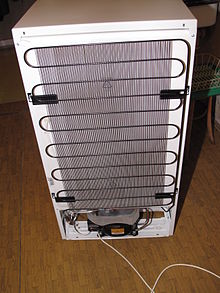Condenser (heat transfer)
This article needs additional citations for verification. (March 2015) |

In systems involving heat transfer, a condenser is a heat exchanger which allows heat transfer from a high-temperature gas passing through it to a cooler liquid or gas outside of it.
When used to condense water vapor back into liquid water, it functions primarily as an expansion chamber with water naturally condensing as its vapor pressure and pressure-elevated boiling point drop. High-pressure steam is the result of water boiling at far over the 212 degrees F/100 degrees C at which pure water boils at sea level at 60 degrees F and 29.92 in.hg.
When the condenser is part of a refrigeration system with a compressor, which actually pumps liquid refrigerant with the resulting pressure increase resulting from flow restriction rather that "compression" of the constant-volume, closed-loop refrigerant supply, and expansion orifice and evaporator, the evaporator removes heat from the air in the refrigerated space as it flows to and through the expansion orifice as a high-pressure liquid. As it flows through the orifice and into the evaporator its pressure and temperature drop dramatically and it becomes a low-pressure, low-temperature liquid.
As it passes through the heat-sink evaporator typically made of aluminum for its light weight, low density and corrosion resistance in contact with dust and water vapor condensing on its surface, the refrigerant is heated as internal air to be refrigerated by having heat removed from it flows over the evaporator. As heat is removed from the air by the refrigerated liquid absorbing it, the liquid becomes hotter and partially or completely boils and is drawn from the evaporator as a high-temperature, low-pressure gas by the pumping compressor located at the condenser outlet. Heat is released at the condenser and the cycle continues until the thermostatic switch which prevents evaporator icing or the internal temperature desired and set by the temperature control thermostat is reached.
In both examples temperature and pressure and state changes take place but in only the latter does the condensor perform all the work of condensing the gas in a continuous cycle. In steam systems and condensers, a feedwater pump injects the condensed water into the boiler as required to maintain the correct boiler water level and the condenser also serves as a de-aeration, makeup water and treatment reservoir. Steam condensers are typically cooled only to the minimum necessary for those to occur as over-cooling would waste fuel and heat energy. In refrigeration system the cooler and more dense the refrigerant leaving the condenser is, the better the system functions and the more efficient it is.
